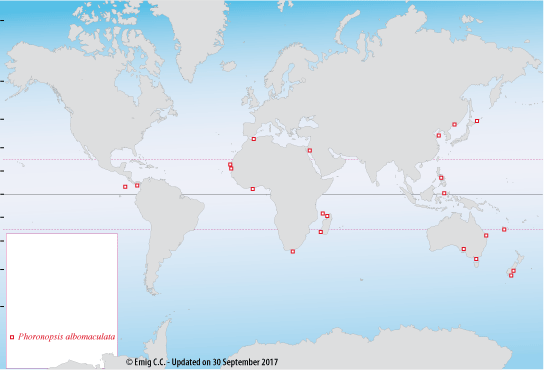|
Phoronopsis albomaculata Gilchrist 1907 Larva: Actinotrocha albomaculata Temereva, 2009 |
 ° References of the most recent published diagnoses
| ||||||
| Diagnosis | ||||||
|
Last update: November 9, 2009 Generally weakly marked collar-fold below the lophophore (genus character): sometimes only marked on the anal side.
Extended specimens more than 150 mm long, diameter 0.5-2 mm.
Sexual reproduction dioecious; females probably having brooding pattern; males with large glandular lophophoral organs. Asexual reproduction by transverse fission. Phoronopsis albomaculata is embedded vertically in soft sediments, from coarse sands to mud, in waters with high levels of suspended materials and under moderate to strong bottom currents. Depth range extends from the intertidal zone to 60 m.
The distribution of Phoronis albomaculata is represented below on the map. Type-locality: False Bay (South Africa) Last update: September 30, 2017  |

|
Dean H. K., Sibaja-Cordero J. A. & J. Cortés, 2010. Occurrence of the phoronid Phoronopsis albomaculata in Cocos Island, Costa Rica. Pacific Science, 64 (3), 459-462. Emig C. C., Roldán & J. M. Viéitez, 2001. Phoronida. In: European Register of Marine Species, a check list of the marine species in Europe and a bibliography of guides to their identification, Costello M. J., Emblow C. & R. White (eds). Patrimoines Naturels, 50, 324-325. References on Phoronopsis albomaculata |
